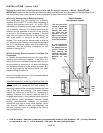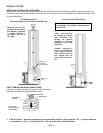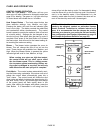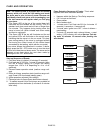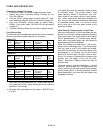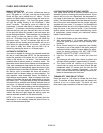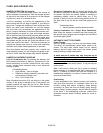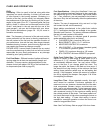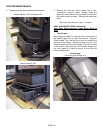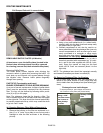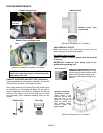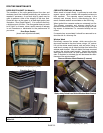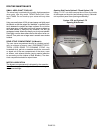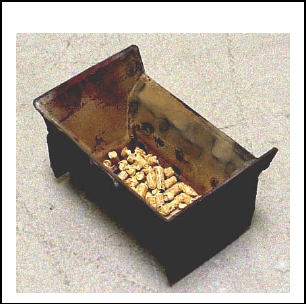
CARE AND OPERATION
PAGE 27
FUEL
Clinkering - Silica (or sand) in the fuel, along with other
impurities, can cause clinkering. A clinker is a hard mass
of silica formed in the burning process. Clinkering is a
function of the fuel, (not the stove), but adversely affects
the performance of the stove by blocking off the air pas-
sages in the grate. Even P.F.I. approved pellet fuel may
tend to clinker. A clinker can be removed from the Ultra-
Grate and placed in the ash pan with the use of the
grate scraper / ash pan tool furnished with your stove.
See Routine Maintenance (pages 28 - 33) for more in-
formation on cleaning.
Ash - The frequency of removal of the ash and mainte-
nance performed on the stove is directly proportional to
the ash content of the fuel and the operation duration of
your pellet stove. Low ash fuel may allow longer intervals
between cleaning, however, a stove burning high ash fuel
may need to be cleaned as often as everyday.
PLEASE NOTE: Lennox Hearth Products has no control
over the manufacturing of pellet fuel and will not be held
responsible for poor stove performance or any damage
caused by poor quality pellet fuels.
Fuel Feed Rates - Different brands of pellets will feed at
varying rates due to their size and density (length and
diameter). This may require a slight adjustment in the
damper control (see pages 12 & 26) or the fuel feed trim
to compensate (see note on page 22).
Fuel Specifications - Using the UltraGrate burn sys-
tem, this appliance has been designed to burn wood resi-
due pellets with up to 3% ash content. Agricultural pellets
(i.e.… Corn, alfalfa etc.) are not permitted to be burned in
the stove. Dirty fuel will adversely affect the performance
of the stove.
Caution: The use of unapproved, dirty, wet and / or high
salt content fuel will void the warranty!
Wood pellets manufactured to the pellet fuels institute
(P.F.I.) certification standard are available in two grades,
Standard and Premium. The primary difference between
the two is the ash content of the pellets.
The P.F.I., specification for standard grade & premium
grade residential pellet fuel is as follows:
• CHLORIDES (Salt): Less than 300 p.p.m.
• BULK DENSITY: 40 lb. / Cu. Ft. minimum
• MOISTURE CONTENT: 8% maximum
• ASH CONTENT: < 3% maximum (standard grade)
< 1% maximum (premium grade)
• FINES: 0.5% maximum through a 1/8” screen
• BTU CONTENT: Minimum 8200 BTU per pound.
Pellet Feed / Pellet Size - The pellet feed system is de-
signed to handle a wide range of pellet sizes up to a
maximum of 5 / 16" diameter. Different pellets may feed
at considerably different rates. You may notice a differ-
ence in the burn if you change pellet fuel sizes. The
longer the pellet, the slower it will feed and vice versa. If
the stove will not stay burning at the minimum fuel feed
setting, those particular pellets may not be feeding fast
enough. If this happens, reduce the amount of combus-
tion air by adjusting the damper. See pages 12 & 26 be-
fore adjusting the damper.
Long Burn Time - When operated correctly, this appli-
ance cannot be overfired. Continuous operation at a
maximum burn can, however, shorten the life of the elec-
trical components (blowers, motors, and electronic con-
trols), and is not recommended. Typical approved opera-
tion would include running at the low to mid range setting
with occasional running on the maximum setting during
the coldest periods of the winter. The blower speed con-
trol should be turned to high when operating the stove on
the high heat setting. A lower heat setting is recom-
mended for overnight operation or when the room is va-
cated for long periods of time.
Note: See Fuel Delivery Rate on page 24 for burn times.
UltraGrate




